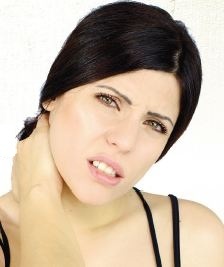Table of Contents
Torticollis definition can be described by the neck’s twisting to only one side. This can happen gradually and can be caused by genetic factors. It could also happen suddenly as a result of injury or trauma. In some cases, torticollis definition may also happen as a reaction to certain medications. Torticollis that is linked with family history and this is known as spasmodic torticollis. The neck or head starts to twist spasmodically, and if left untreated, this disorder can become permanent.
Extreme Pain
The disorder usually starts between the ages of 31 and 50 years. Another type is called acute torticollis which develops when the head or neck twists excessively. When this condition happens, the person will most likely keep the head bent or straight to only one side due to pain because if the patient moves the neck towards the other side this can lead to extreme pain. The neck muscles that are affected on one side can also become painful and tender. If this is the case, a medical exam is needed in order to examine the nerve and motor functioning so that the spinal cord injury can be ruled out. In this article, we’ll discuss further the definition of torticollis.
Torticollis definition is characterized by a twisting of the neck to one side. This may occur gradually due to hereditary factors. It could also occur suddenly as a result of trauma or injury. In some cases, the torticollis definition may also occur as a reaction to certain medications. Torticollis that is associated with a family history is known as spasmodic torticollis. Initially, the neck starts twisting spasmodically and if left untreated, it can become permanent. The condition usually begins between the ages of 31 and 50 years.
Acute torticollis develops when the neck is twisted excessively. When this happens, the individual is likely to keep the head straight or bent to one side due to discomfort. Moving the neck towards the opposite side may lead to severe pain. The neck muscles on the affected side may also become tender and painful. In such cases, a medical examination is necessary to examine motor and nerve function so that spinal cord injury may be ruled out. In this article, we will discuss further the definition of torticollis.
Torticollis Definition: Causes
In order to define torticollis, we need to look at its causes. The causes of torticollis can come from the abuse of certain drugs such as prescription drugs, amphetamines, and cocaine. Such drugs can lead to dystonia or lack of control in the muscles. This disorder is described by a sudden involuntary movement of the back, facial and neck muscles. Tongue protrusion and also eye deviation may also happen. Acute torticollis is not usually a serious condition. However, it is advisable to consult a doctor if there are muscle pain and stiffness. Neck injuries must be attended to early.
Torticollis Definition: Symptoms
There are various symptoms that can occur along with torticollis’ definition. These may be linked to some type of issues in the central nervous system which should be examined immediately. The symptoms of torticollis include the following:
- weakness in the limbs
- swallowing difficulties
- breathing trouble
- a tingling sensation in the limbs
- speech impairment
- difficulty while walking
Torticollis Definition: Diagnosis
For us to define torticollis further we now take a look at the diagnosis, the underlying anatomical distortion causing torticollis is a shortened sternocleidomastoid muscle. The sternocleidomastoid muscle is a neck muscle that originates from the clavicle and sternum and inserts on the temporal bone on the same side where the mastoid process occurs. There are two types of these, and if both are contracted, that’s how the neck is flexed.
The main supply of blood for these muscles comes from the occipital arteries, superior thyroid arteries, transverse scapular arteries and transversal cervical arteries. The main innervations for these muscles are from the accessory nerve but the second, third and fourth cervical nerves are also involved. Pathology in the nerve supply and blood may lead to torticollis.
For children, evaluation of torticollis starts with anamnesis in order to pin point the circumstances that happened during childbirth as well as the possibility of related symptoms or even trauma. Physical examination shows decreased rotation and bends to the opposite side of the affected muscle.
Radiographic Cervical Spine
Some researchers say that innate cases usually involve the right side though there is no complete agreement yet about this claim. The evaluation needs to have a thorough neurologic exam and if the patient is diagnosed with hip/ crown hip dysplasia then that also needs to be examined.
Radiographic cervical spine should also be obtained in order to rule out the clear bone abnormalities and MRI should also be considered if there are concerns about structural problems and other disorders or conditions. Ultrasonography is another tool that is being used to diagnose the disorder. This has high frequency sound waves used to visualize muscle tissue. Color histograms are also used to determine the cross-sectional area and the thickness of the muscles in the neck area.
Evaluation by an optometrist should also be considered in kids in order to ensure that the torticollis definition is not caused by any type of vision problems. Cervical dystonia that appears when patients reach adulthood was believed to be idiopathic and this is because special imaging techniques usually don’t have any specific cause.
Torticollis Definition: Treatment
For us to define torticollis further we now take a look at the treatment options. Treatment for torticollis is usually focused on relaxing the affected neck muscles. This can include surgery, medication, or physiotherapy. Most patients who suffer from torticollis usually recover in just a couple of weeks. However, they could still experience some form of neck problems after that.
What patients can do is to do some stretches particularly in the area of the neck as it has been proven effective to provide relief from painful symptoms. Heat compress and massage can also treat torticollis and can help alleviate the pain. Muscle spasms may also be alleviated by letting the patient wear a neck brace. There are cases when surgery is needed in order to treat the contracted neck muscle. This is done if other treatment methods are unsuccessful. The good thing is that torticollis is much easier to treat in kids.
Chronic Pain Treatment
A few days is usually enough to ease the pain. Chronic pain treatment often includes analgesia, physiotherapies like neck stretching, neck exercises or neck massage. If the patient exhibits torticollis, by definition, it will appear that their head is flexed to the painful side to a certain point, and at the same time will also be turned away from the painful area.
One of the first indications is when a person is
aware of is the sudden pain on one side of the neck, often severe and lower in
the neck. Nerve root problems are usually somewhat slower in onset but if the
symptoms presented on waking this could be the diagnosis. The outcome is very
likely to be just as good as the muscle or joint strain which is more common,
but recovery typically takes longer over a period of weeks. The most common
physiotherapy management includes ice, use of a collar if indicated, and also a
gentle tractioning of the neck relax the neck muscles and settle pain. We hope
you learn a lot about torticollis’ definition, causes, symptoms,
diagnosis, and treatment.






 I love to write medical education books. My books are written for everyone in an easy to read and understandable style.
I love to write medical education books. My books are written for everyone in an easy to read and understandable style.
